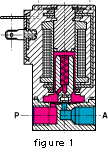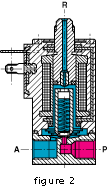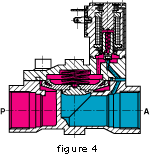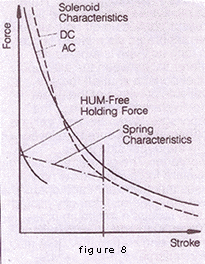|
Technical
Principles of Valves
GENERAL
Solenoid
valves are used wherever fluid flow has to be controlled automatically.
They are being used to an increasing degree in the most varied
types of plants and equipment. The variety of different designs
which are available enables a valve to be selected to specifically
suit the application in question.
CONSTRUCTION
Solenoid
valves are control units which, when electrically energized or
de-energized, either shut off or allow fluid flow. The actuator
takes the form of an electromagnet. When energized, a magnetic
field builds up which pulls a plunger or pivoted armature against
the action of a spring. When de-energized, the plunger or pivoted
armature is returned to its original position by the spring action.
VALVE
OPERATION
According
to the mode of actuation, a distinction is made between direct-acting
valves, internally piloted valves, and externally piloted valves.
A further distinguishing feature is the number of port connections
or the number of flow paths ("ways").
DIRECT-ACTING
VALVES
With
a direct-acting solenoid valve, the seat seal is attached to the
solenoid core. In the de-energized condition, a seat orifice is
closed, which opens when the valve is energized.
 DIRECT-ACTING
2-WAY VALVES DIRECT-ACTING
2-WAY VALVES
Two-way
valves are shut-off valves with one inlet port and one outlet
port (Fig. 1). In the de-energized condition, the core spring,
assisted by the fluid pressure, holds the valve seal on the valve
seat to shut off the flow. When energized, the core and seal are
pulled into the solenoid coil and the valve opens. The electro-magnetic
force is greater than the combined spring force and the static
and dynamic pressure forces of the medium.
 DIRECT-ACTING
3-WAY VALVES DIRECT-ACTING
3-WAY VALVES
Three-way
valves have three port connections and two valve seats. One valve
seal always remains open and the other closed in the de-energized
mode. When the coil is energized, the mode reverses. The 3-way
valve shown in Fig. 2 is designed with a plunger type core. Various
valve operations can be obtained according to how the fluid medium
is connected to the working ports in Fig. 2. The fluid pressure
builds up under the valve seat. With the coil de-energized, a
conical spring holds the lower core seal tightly against the valve
seat and shuts off the fluid flow. Port A is exhausted through
R. When the coil is energized the core is pulled in, the valve
seat at Port R is sealed off by the spring-loaded upper core seal.
The fluid medium now flows from P to A.
 Unlike
the versions with plunger-type cores, pivoted-armature valves
have all port connections in the valve body. An isolating diaphragm
ensures that the fluid medium does not come into contact with
the coil chamber. Pivoted-armature valves can be used to obtain
any 3-way valve operation. The basic design principle is shown
in Fig. 3. Pivoted-armature valves are provided with manual override
as a standard feature. Unlike
the versions with plunger-type cores, pivoted-armature valves
have all port connections in the valve body. An isolating diaphragm
ensures that the fluid medium does not come into contact with
the coil chamber. Pivoted-armature valves can be used to obtain
any 3-way valve operation. The basic design principle is shown
in Fig. 3. Pivoted-armature valves are provided with manual override
as a standard feature.
INTERNALLY
PILOTED SOLENOID VALVES
With
direct-acting valves, the static pressure forces increase with
increasing orifice diameter which means that the magnetic forces,
required to overcome the pressure forces, become correspondingly
larger. Internally piloted solenoid valves are therefore employed
for switching higher pressures in conjunction with larger orifice
sizes; in this case, the differential fluid pressure performs
the main work in opening and closing the valve.
 INTERNALLY
PILOTED 2-WAY VALVES INTERNALLY
PILOTED 2-WAY VALVES
Internally piloted solenoid valves are fitted with either a 2-
or 3-way pilot solenoid valve. A diaphragm or a piston provides
the seal for the main valve seat. The operation of such a valve
is indicated in Fig. 4. When the pilot valve is closed, the fluid
pressure builds up on both sides of the diaphragm via a bleed
orifice. As long as there is a pressure differential between the
inlet and outlet ports, a shut-off force is available by virtue
of the larger effective area on the top of the diaphragm. When
the pilot valve is opened, the pressure is relieved from the upper
side of the diaphragm. The greater effective net pressure force
from below now raises the diaphragm and opens the valve. In general,
internally piloted valves require a minimum pressure differential
to ensure satisfactory opening and closing. Omega also offers
internally piloted valves, designed with a coupled core and diaphragm
that operate at zero pressure differential (Fig. 5).
 INTERNALLY
PILOTED MULTI-WAY SOLENOID VALVES INTERNALLY
PILOTED MULTI-WAY SOLENOID VALVES
Internally
piloted 4-way solenoid valves are used mainly in hydraulic and
pneumatic applications to actuate double-acting cylinders. These
valves have four port connections: a pressure inlet P, two cylinder
port connections A and B, and one exhaust port connection R. An
internally piloted 4/2-way poppet valve is shown in Fig. 6. When
de-energized, the pilot valve opens at the connection from the
pressure inlet to the pilot channel. Both poppets in the main
valve are now pressurized and switch over. Now port connection
P is connected to A, and B can exhaust via a second restrictor
through R.
 EXTERNALLY
PILOTED VALVES EXTERNALLY
PILOTED VALVES
With
these types an independent pilot medium is used to actuate the
valve. Fig. 7 shows a piston-operated angle-seat valve with closure
spring. In the unpressurized condition, the valve seat is closed.
A 3-way solenoid valve, which can be mounted on the actuator,
controls the independent pilot medium. When the solenoid valve
is energized, the piston is raised against the action of the spring
and the valve opens. A normally-open valve version can be obtained
if the spring is placed on the opposite side of the actuator piston.
In these cases, the independent pilot medium is connected to the
top of the actuator. Double-acting versions controlled by 4/2-way
valves do not contain any spring.
MATERIALS
All
materials used in the construction of the valves are carefully
selected according to the varying types of applications. Body
material, seal material, and solenoid material are chosen to optimize
functional reliability, fluid compatibility, service life and
cost.
BODY
MATERIALS
Neutral fluid valve bodies are made of brass and bronze. For fluids
with high temperatures, e.g., steam, corrosion-resistant steel
is available. In addition, polyamide material s used for economic
reasons in various plastic valves.
SOLENOID
MATERIALS
All
parts of the solenoid actuator which come into contact with the
fluid are made of austenitic corrosion-resistant steel. In this
way, resistance is guaranteed against corrosive attack by neutral
or mildly aggressive media.
SEAL
MATERIALS
The
particular mechanical, thermal and chemical conditions in an application
factors in the selection of the seal material. the standard material
for neutral fluids at temperatures up to 194°F is normally FKM.
For higher temperatures EPDM and PTFE are employed. The PTFE material
is universally resistant to practically all fluids of technical
interest.
PRESSURE
RATINGS - PRESSURE RANGE
All pressure figures quoted in this section represent gauge pressures.
Pressure ratings are quoted in PSI. The valves function reliably
within the given pressure ranges. Our figures apply for the range
15% undervoltage to 10% overvoltage. If 3/2-way valves are used
in a different operation, the permitted pressure range changes.
Further details are contained in our data sheets.
In
the case of vacuum operation, care has to be taken to ensure that
the vacuum is on the outlet side (A or B) while the higher pressure,
i.e. atmospheric pressure, is connected to the inlet port P.
FLOW
RATE VALUES
The
flow rate through a valve is determined by the nature of the design
and by the type of flow. The size of valve required for a particular
application is generally established by the Cv rating. This figure
is evolved for standardized units and conditions, i.e. flowrate
in GPM and using water at a temperature of between 40°F and 86°F
at a pressure drop of 1 PSI. Cv ratings for each valve are quoted.
A standardized system of flowrate values is also used for pneumatics.
In this case the air flow in SCFM upstream and a pressure drop
of 15 PSI at a temperature of 68°F.
SOLENOID
ACTUATOR
A
common feature of all Omega solenoid valves is the epoxy-encapsulated
solenoid system. With this system, the whole magnetic circuit-coil,
connections, yoke and core guide tube - are incorporated in one
compact unit. This results in a high magnetic force being contained
within the minimum of space, insuring first class electrical insulation
and protection against vibration, as well as external corrosive
effects.
COILS
The
Omega coils are available in all the commonly used AC and DC voltages.
The low power consumption, in particular with the smaller solenoid
systems, means that control via solid state circuitry is possible.
 The
magnetic force available increases as the air gap between the
core and plug nut decreases, regardless of whether AC or DC is
involved. An AC solenoid system has a larger magnetic force available
at a greater stroke than a comparable DC solenoid system. The
characteristic stroke vs. force graphs, indicated in Fig. 8, illustrate
this relationship. The
magnetic force available increases as the air gap between the
core and plug nut decreases, regardless of whether AC or DC is
involved. An AC solenoid system has a larger magnetic force available
at a greater stroke than a comparable DC solenoid system. The
characteristic stroke vs. force graphs, indicated in Fig. 8, illustrate
this relationship.
The
current consumption of an AC solenoid is determined by the inductance.
With increasing stroke the inductive resistance decreases and
causes an increase in current consumption. This means that at
the instant of de-energization, the current reaches its maximum
value. The opposite situation applies to a DC solenoid where the
current consumption is a function only of the resistance of the
windings. A time-based comparison of the energization characteristics
for AC and DC solenoids is shown in Fig. 9. At the moment of being
energized, i.e. when the air gap is at its maximum, solenoid valves
draw much higher currents than when the core is completely retracted,
i.e., the air gap is closed. This results in a high output and
increased pressure range. In DC systems, after switching on the
current, flow increases relatively slowly until a constant holding
current is reached. These valves are therefore, only able to control
lower pressures than AC valves at the same orifice sizes. Higher
pressures can only be obtained by reducing the orifice size and,
thus, the flow capability.
 THERMAL
EFFECTS THERMAL
EFFECTS
A certain amount of heat is always generated when a solenoid coil
is energized. The standard version of the solenoid valves has
relatively low temperature rises. They are designed to reach a
maximum temperature rise of 144°F under conditions of continuous
operation (100%) and at 10% overvoltage. In addition, a maximum
ambient temperature of 130°F is generally permissible. The maximum
permissible fluid temperatures are dependent on the particular
seal and body materials specified. These figures can be obtained
from the technical data.
TIME
DEFINITIONS (VDE0580) RESPONSE TIMES
The
small volumes and relatively high magnetic forces involved with
solenoid valves enable rapid response times to be obtained. Valves
with various response times are available for special applications.
The response time is defined as the time between application of
the switching signal and completion of mechanical opening or closing.
ON
PERIOD
The
on period is defined as the time between switching the solenoid
current on and off.
CYCLE
PERIOD
The
total time of the energized and de-energized periods is the cycle
period. Preferred cycle period: 2, 5, 10 or 30 minutes.
RELATIVE
DUTY CYCLE
The
relative duty cycle (%) is the percentage ratio of the energized
period to the total cycle period. Continuous operation (100% duty
cycle) is defined as continuous operation until steady-state temperature
is reached.
VALVE
OPERATION
The
coding for the valve operation always consists of a capital letter.
The summary at left details the codes of the various valve operations
and indicates the appropriate standard circuit symbols.
VISCOSITY
The
technical data is valid for viscosities up to the figure quoted.
Higher viscosities are permissible, but in these cases the voltage
tolerance range is reduced and the response times are extended.
TEMPERATURE
RANGE
Temperature
limits for the fluid medium are always detailed. Various factors,
e.g. ambient conditions, cycling, speed, voltage tolerance, installation
details, etc., can, however, influence the temperature performance.
The values quoted herein should, therefore, be used only as a
general guide. In cases where operation at extremes of the temperature
range are involved, you should seek advice from Omega's Engineering
Department.
Reproduced
with permission of Burkert Contromatic Corporation
| 






